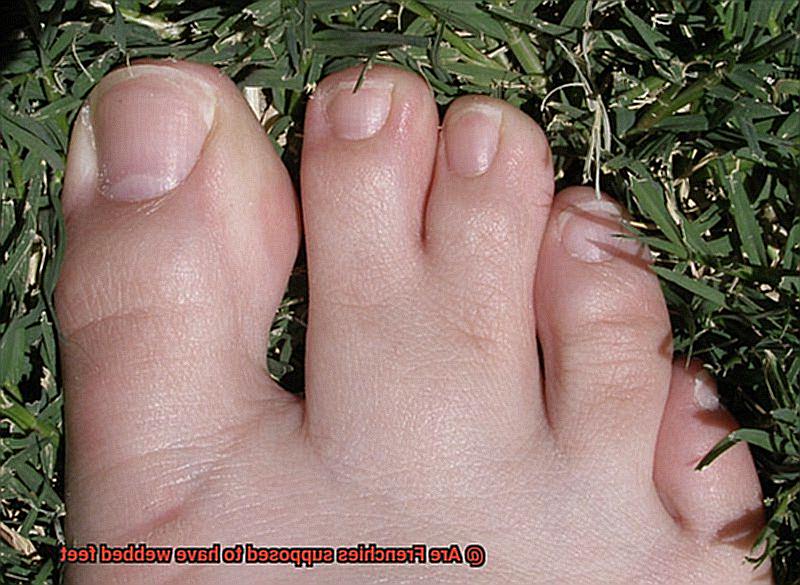Are Frenchies supposed to have webbed feet?
Today, we’re diving into a question that’s got French Bulldog fans scratching their heads – do these little cuties actually have webbed feet? With their squished faces and bat-like ears, Frenchies have stolen the hearts of dog lovers worldwide.
But when it comes to their paws, things get a bit murky. Are these compact canines hiding some hidden webbing like their water-loving counterparts?
So, whether you’re a proud Frenchie owner or just curious about canine anatomy, let’s untangle this mystery together.
Are Frenchies supposed to have webbed feet
Contents
- 1 Are Frenchies supposed to have webbed feet
- 2 Should Frenchies Have Webbed Feet?
- 3 What Is the Breed Standard for French Bulldogs?
- 4 Are All Dogs Born with Webbed Feet?
- 5 Is There Any Variation Amongst French Bulldog Feet?
- 6 Do Webbed Feet Affect a Dog’s Ability to Walk or Function Normally?
- 7 What Other Breeds of Dogs Have Webbed Feet?
- 8 What Are the Benefits of Having Webbed Feet for Water-Loving Breeds?
- 9 How Can You Tell If Your French Bulldog Has Webbed Feet?
- 10 Conclusion
French Bulldogs, also known as Frenchies, are beloved for their adorable appearance and friendly nature. As a proud owner of a Frenchie, you may have wondered if these dogs are supposed to have webbed feet. In this blog post, we will explore the truth behind this common question and provide you with expert insights.
Webbed Feet: Not a Breed Standard:
Contrary to popular belief, webbed feet are not a standard characteristic of French Bulldogs. While some individual Frenchies may have slight webbing between their toes, it is not something that breeders aim for or prioritize. The American Kennel Club (AKC), the authority on breed standards, does not mention webbed feet in their description of French Bulldogs.
French Bulldogs and Swimming:
French Bulldogs are not natural swimmers like Labrador Retrievers or other water-loving breeds. Their body structure and short muzzle make swimming more challenging for them. While they may enjoy wading in shallow water or playing near the beach, they are not built for extensive swimming sessions. Therefore, webbed feet, which aid in swimming efficiency, are not necessary for Frenchies.
The Ideal Foot Structure:
French Bulldogs have compact and well-rounded feet with well-arched toes. Their feet are designed for stability and balance rather than water activities. The breed’s strong foot structure contributes to their overall agility and ability to move comfortably.
Individual Variations:
It is important to remember that there can be variations within a breed. Some French Bulldogs may exhibit slight webbing between their toes due to genetic factors or individual variation. However, this should not be confused with the webbed feet commonly seen in water-retrieving breeds.
Consulting a Veterinarian:
If you notice any unusual features on your French Bulldog’s feet or have concerns about their overall health, it is always advisable to consult with a veterinarian. They can assess your dog’s specific situation and provide guidance based on their professional expertise.
Should Frenchies Have Webbed Feet?
French Bulldogs are known for their distinctive appearance and lovable personality. However, one question that often perplexes French Bulldog owners is whether or not their furry companions should have webbed feet. In this blog post, we will dive into the fascinating world of French Bulldog genetics to understand why some Frenchies have webbed feet while others do not.
The Origins of the French Bulldog:
French Bulldogs were originally bred in England as miniature versions of the English Bulldog. Unlike breeds developed for swimming or water-related tasks, Frenchies were primarily bred as companion dogs. Their ancestors did not require webbed feet for their intended purpose, which was to provide affection and companionship to their owners.
Webbed Feet: A Minor Variation:
While it is true that some individual French Bulldogs may exhibit webbing between their toes, it is considered a minor variation within the breed. This variation does not affect their overall health or ability to function as a loving companion. The presence of webbed feet in French Bulldogs can be attributed to genetic factors or the influence of distant ancestors who possessed this trait.
The Influence of English Bulldogs:
Some theories suggest that webbed feet in French Bulldogs may have been inherited from their English Bulldog ancestors. Although not all English Bulldogs exhibit this trait, occasional instances of webbed feet in English Bulldogs support this hypothesis. However, further research is needed to confirm this connection.
No Advantage or Disadvantage:
It is important to note that the presence of webbed feet in French Bulldogs does not provide any significant advantage or disadvantage to the breed. Their compact body structure and relatively short legs make them less suited for activities like swimming compared to breeds specifically bred for water-related tasks.
Embrace Your Frenchie’s Uniqueness:
If your French Bulldog does have webbed feet, there is no need to be concerned. It is simply a minor physical variation within the breed and does not require any specific care or attention. Embrace your Frenchie’s uniqueness and focus on providing them with a loving and nurturing environment.
What Is the Breed Standard for French Bulldogs?
French Bulldogs, or Frenchies as they are affectionately called, have become one of the most popular dog breeds worldwide. Their unique appearance and lovable personalities have won the hearts of many dog enthusiasts. But what exactly makes a Frenchie a Frenchie? Let’s dive into the breed standard and uncover the secrets behind these adorable bat-eared canines.
The Perfect Build: Compact and Muscular
French Bulldogs should have a compact and muscular build. Their bodies should be well-proportioned, with a broad chest and deep brisket. This gives them a sturdy and powerful appearance, despite their small size. So, don’t let their petite stature fool you – these little dogs pack a punch.
Head Shape: Squaring It Off
When it comes to head shape, Frenchies have a distinct look. The breed standard calls for a square-shaped head with a flat skull between the ears. Their muzzle should be short and broad, with a well-defined stop. And let’s not forget those adorable wrinkles that make their faces so irresistible.
Size Matters: From Shoulder to Tail
French Bulldogs come in a range of sizes, but there are guidelines to follow. Ideally, they should stand between 11 to 12 inches at the shoulder. As for weight, it should range from 16 to 28 pounds. However, it’s important to note that variations in size can occur within the breed, and Frenchies can still be considered within the standard as long as they meet the overall conformation requirements.
Coat Colors: A Palette of Possibilities
French Bulldogs are known for their beautiful coat colors. The breed standard recognizes various acceptable colors and patterns, including brindle, fawn, cream, white, and pied (a combination of white with any other color). However, solid black or liver-colored coats are considered non-standard. So, whether your Frenchie is a dazzling brindle or a stylish fawn, they are all equally stunning.
Those Ears: Bat-Like and Adorable
Arguably one of the most distinctive features of French Bulldogs is their bat-like ears. According to the breed standard, their ears should be large and erect, set high on the head. They should be wide at the base and rounded at the top.
The preference is for “rose” ears, meaning that the ears fold back and expose the inner edges, creating a unique and endearing expression. It’s these adorable ears that truly make Frenchies stand out in a crowd.
Are All Dogs Born with Webbed Feet?
If you’re a proud owner of a French Bulldog, you may have wondered if your furry friend has webbed feet like some other dog breeds. While webbed feet are a trait commonly associated with certain dog breeds, such as the Labrador Retriever and the Portuguese Water Dog, French Bulldogs do not typically have this characteristic.
So why don’t French Bulldogs have webbed feet? Well, it all comes down to genetics. Different breeds have different foot structures and characteristics that serve specific purposes. Webbed feet, for example, help certain breeds swim more efficiently by providing better propulsion and stability in water. But French Bulldogs, with their compact and well-rounded feet, are not known for their swimming abilities.
But fear not. Just because French Bulldogs don’t have webbed feet doesn’t mean they aren’t amazing companions and family pets. These adorable bat-eared buddies have plenty of other fantastic qualities that make them special. With their muscular build, broad chest, and short coat that requires minimal grooming, French Bulldogs are known for their friendly and affectionate nature.
It’s important to note that while some French Bulldogs may exhibit slight variations in their foot structure, webbed feet are not a characteristic of the breed as a whole. If you notice any abnormalities or concerns with your French Bulldog’s feet, it’s always a good idea to consult with a veterinarian for an accurate diagnosis and appropriate treatment.
Is There Any Variation Amongst French Bulldog Feet?
French Bulldogs are known for their distinctive appearance, including their compact size, bat-like ears, and short snouts. But did you know that there is also some variation among their feet? In this article, we’ll explore the different types of feet you may come across in French Bulldogs, and what it means for their overall health and well-being.
Size and Shape
Generally, French Bulldogs have small, compact feet with well-arched toes. The feet should be round and firm, providing a solid base of support for the dog’s body. However, there can be some variations in terms of size and shape. Some Frenchies may have slightly larger or smaller feet than the standard, but as long as they are proportionate to the dog’s body, it is not considered a major concern.
Webbed Feet
Another variation that can occur is the presence of webbing between the toes. Webbed feet, which are more commonly found in water-loving breeds like Labradors or Newfoundlands, can occasionally be seen in French Bulldogs too. However, it should be noted that webbed feet are not a breed requirement for French Bulldogs. The breed standard does not specifically mention webbing as a desirable trait.
True Webbed Feet vs Fused Toes
It is important to distinguish between true webbed feet and slightly fused toes. Some French Bulldogs may have toes that are fused together at the base but separate further up. This can give the appearance of webbing but is not the same as true webbed feet.
True webbed feet in French Bulldogs may be seen as an inherited trait from ancestors with water-loving backgrounds. It is believed to be a result of genetic influence from other breeds or individual variation within the breed’s gene pool.
Foot Health
While webbed feet do not typically affect a French Bulldog’s ability to walk or run, they may be more prone to certain foot-related issues such as fungal infections or ingrown nails due to reduced airflow and increased moisture between the toes. If a French Bulldog has webbed feet, it is important to regularly inspect and clean between the toes to prevent any potential issues. Consulting with a veterinarian for proper foot care recommendations is also advised.
Do Webbed Feet Affect a Dog’s Ability to Walk or Function Normally?
French Bulldogs, or Frenchies as they are affectionately known, are a popular breed with their adorable squished faces and bat-like ears. But when it comes to their feet, do they have webbed wonders or fused toes? Let’s dive into the world of French Bulldog feet and explore how they affect these lovable pups’ ability to walk and function normally.
French Bulldogs: No Webbed Feet Here.
Unlike water-loving breeds that boast webbed feet for enhanced swimming abilities, French Bulldogs do not possess this characteristic. Their feet are compact and sturdy, designed for walking and maneuvering on land rather than paddling through water. So, if you were hoping your Frenchie would be your new swimming buddy, you might have to reconsider.
The Impact of Webbed Feet on Mobility
While webbed feet can be advantageous for dogs bred for water activities, they may pose challenges for land-based mobility.
The webbing between the toes can limit flexibility and range of motion in the foot, making it difficult for dogs to walk comfortably on solid ground.
However, this is not a concern for French Bulldogs, as their feet are not webbed.
French Bulldogs: Agile and Graceful on Land
Frenchies have a unique body structure that contributes to their distinctive gait. With slightly longer hind legs than front legs, they move with agility and grace despite lacking webbed feet.
Their sturdy and well-structured feet allow them to navigate various terrains without any significant issues. So, rest assured that your Frenchie can prance around the park or strut their stuff on the sidewalk with ease.
Other Factors to Consider
While French Bulldogs may not have webbed feet that impact their ability to walk normally, they can still face certain health issues that affect their mobility.
One common condition is hip dysplasia, where the hip joint doesn’t develop properly, leading to discomfort and mobility challenges.
It’s important for Frenchie owners to monitor their dog’s gait and seek veterinary attention if any abnormalities or difficulties arise.
Foot Care Tips for French Bulldogs
While French Bulldogs may not have webbed feet, proper foot care is still essential for their overall health and well-being. Here are some tips to keep those paws in tip-top shape:
- Regularly trim their nails to prevent overgrowth and discomfort.
- Keep the area between the toes clean and free from debris.
- Check for any signs of irritation, redness, or swelling on the foot pads.
- Avoid walking your Frenchie on hot pavement or rough surfaces that could cause injuries.
What Other Breeds of Dogs Have Webbed Feet?

While your beloved pooches may not have webbed feet like some other breeds, it’s always fascinating to learn about the diverse traits and characteristics that dogs possess. In this article, we’ll dive into the world of dog breeds with webbed feet, shedding light on their aquatic prowess and why these unique adaptations are so cherished. So, grab a cup of café au lait and let’s explore.
Water-Loving Breeds:
Webbed feet are commonly associated with water-loving dog breeds. These exceptional canines have evolved to excel in aquatic activities such as swimming and retrieving. Some notable examples include:
- Retrievers: Labrador Retrievers and Golden Retrievers are renowned for their webbed feet, which aid them in retrieving game from water. Their powerful strokes make them excellent swimmers.
- Newfoundlands: These gentle giants were originally bred for water rescue. Their webbed feet contribute to their remarkable swimming abilities, making them natural lifeguards.
- Portuguese Water Dogs: Historically used by Portuguese fishermen, these intelligent and energetic dogs possess webbed feet that assist in retrieving nets and other items from the water.
Sporting Breeds:
Several sporting breeds also boast webbed feet, enhancing their swimming skills for water-based activities. Here are a few examples:
- Irish Water Spaniel: This curly-coated breed is known for its impressive swimming ability, thanks in part to its webbed feet. They’re often seen competing in water trials with great enthusiasm.
- Chesapeake Bay Retriever: With their strong build and webbed feet, Chesapeake Bay Retrievers are expert swimmers and excel in retrieving game from both land and water.
Other Webbed-Footed Breeds:
While not as widely recognized for their webbed feet, these breeds also possess this unique trait:
- Otterhound: These large scent hounds have webbed feet that assist them in hunting otters in water. Their webbing, along with their excellent sense of smell, makes them formidable trackers.
- Nova Scotia Duck Tolling Retriever: As their name suggests, these retrievers are skilled at luring ducks within range of hunters. Their webbed feet enable them to navigate through water effortlessly.
- Flat-Coated Retriever and Irish Setter: These elegant breeds may not be as commonly associated with webbed feet, but they possess this characteristic to varying degrees.
What Are the Benefits of Having Webbed Feet for Water-Loving Breeds?
While our adorable bat-eared buddies may not have webbed feet like some water-loving breeds, it doesn’t mean they can’t enjoy splashing around in the water. However, understanding the advantages of webbed feet for water-loving breeds can give us a greater appreciation for how these amazing canines navigate aquatic adventures. So, let’s dive right in.
Increased Propulsion:
Webbed feet act like natural paddles, providing an extra push against the water and propelling water-loving breeds forward with ease. It allows them to swim more efficiently, making those graceful strokes look effortless.
Enhanced Stability and Balance:
The additional surface area created by webbed feet helps water-loving breeds stay afloat and maintain balance in the water. It’s like having built-in floaties that provide stability, even in rough waters or strong currents.
Improved Agility:
Webbing enables precise control and coordination of movements while swimming, allowing water-loving breeds to change direction swiftly, make sharp turns, and adjust their speed effortlessly. It’s like having built-in navigation systems.
Versatile Water Activities:
Water-loving breeds with webbed feet excel in various aquatic activities such as dock diving, water retrieval games, and even water rescue missions. Their webbed feet provide them with an advantage in tasks that require efficiency and agility in the water.
Easy Maintenance:
Even if your French Bulldog doesn’t have webbed feet, fear not. Webbing is also beneficial for breeds that spend time in wet or muddy environments. It prevents mud or debris from getting stuck between the toes, making paw cleaning sessions a breeze.
Conclusion:
While our beloved French Bulldogs may not possess the webbed wonders of their water-loving counterparts, it doesn’t dampen their enthusiasm for aquatic adventures. Remember to enjoy the water safely and provide proper supervision during swimming sessions. So, whether your Frenchie is doggy-paddling or splashing around, embrace their love for water and cherish the unique traits that make them who they are.
How Can You Tell If Your French Bulldog Has Webbed Feet?
The French Bulldog – a lovable, playful, and sometimes quirky companion. But have you ever wondered if your Frenchie has webbed feet? In this blog post, we’ll explore the signs that may indicate whether your furry friend has this fascinating trait. So, grab your magnifying glass and let’s dive into the mystery.
Paw Inspection:
To start our investigation, closely examine your Frenchie’s paws. Look for any skin or membrane that extends between the toes, resembling a partial or full web. Remember, this unique feature is more commonly seen in water-loving animals like ducks or otters. However, some French Bulldogs might surprise you with their webbed wonders.
Swimming Skills:
If your Frenchie enjoys a dip in the pool or a frolic at the beach, pay close attention to their swimming abilities. Webbed feet are designed to provide better propulsion through the water. So, if your Frenchie effortlessly glides and paddles like a pro, it could be a strong clue that they possess those marvelous webbed paws.
Walking Style:
Take note of how your Frenchie walks on different surfaces. Dogs with webbed feet often have a distinctive gait on land due to the unique structure of their paws. You might observe a slightly wider stance with toes splayed outward. This adaptation can provide them with better stability on uneven terrains – perfect for adventurous walks or hikes.
Remember:
Not all French Bulldogs will have webbed feet as it is not a standard characteristic of the breed. Each Frenchie is unique in their own special way, whether they possess webbed feet or not. So don’t fret if your little companion doesn’t have this particular feature – they’re still extraordinary just the way they are.
Seek Expert Advice:
If you’re still unsure about your Frenchie’s webbed feet, it’s always a good idea to consult with a veterinarian or a knowledgeable breeder. They can provide professional guidance and examine your Frenchie’s paws to determine if they possess this fascinating trait.
f3XueAlb5Q4″ >
Conclusion
French Bulldogs, known for their adorable and distinctive appearance, are often subject to discussions about their unique features. One such feature that sparks curiosity is the idea of webbed feet. While it is true that some Frenchies may possess slightly webbed toes, it is not a characteristic that all members of this breed are supposed to have.
The presence of webbing between a Frenchie’s toes can be attributed to their distant ancestors, the English Bulldogs. These ancestors were known to have webbed feet, which aided them in swimming and navigating through water bodies. Over time, as French Bulldogs were bred from English Bulldogs, some individuals inherited this trait.
However, it is important to note that webbed feet in Frenchies are not as pronounced or functional as those in certain other breeds like Labrador Retrievers or Newfoundlands. In most cases, the webbing is minimal and does not serve any practical purpose for these little canines.
So why do some French Bulldogs still have remnants of this ancestral trait? Well, genetics play a significant role. Certain genes responsible for webbed feet might still be present in the Frenchie gene pool due to their shared lineage with English Bulldogs. As a result, occasional instances of slight webbing can be observed among Frenchies.
It’s crucial to remember that while webbed feet might add an interesting twist to the already captivating appearance of French Bulldogs, they are not considered a defining characteristic of the breed. Breed standards set by kennel clubs do not require or promote webbed feet in Frenchies.
In conclusion, if you come across a Frenchie with slightly webbed toes, consider it an intriguing quirk rather than an expected feature.




